Scratch E-Qualizer Original Design / Scratch Built
Scratch - E-Qualizer {Scratch}
Contributed by Larry Brand
| Manufacturer: | Scratch |
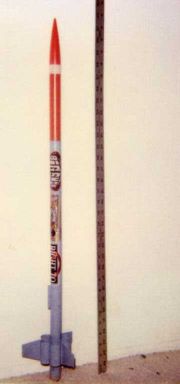
Brief:
I built the E-Qualizer as one of four experimental designs used for my NARTREK
Gold project. Only one survived the required 6 test flights and E-Qualizer
wasn't the one. E-Qualizer was an exercise to create a model optimized for the
long-burning, heavy, low initial thrust Estes E9-8 motor. It combines narrow
diameter and light weight with both conventional and tube fins to move the CP
well towards the aft end to balance the heavy motor. I have since found better
ways to do this. All that aside, it is a fun model to build and fly, which is
why I'm sharing it.
Construction:
To keep the experiment simple, I built E-Qualizer by re-combining the
components of the Custom Rockets Razor and the Vaughn Bros. TFNC kits.
Unfortunately, the excellent Vaughn product line is no longer available.
E-Qualizer is a deluxe design including G10 glass fins, a payload compartment large enough for a Perfectflite micro altimeter, and a nylon chute recovery system attached with a mini-carabiner.
Construction uses 5-minute epoxy (no Elmer's glue) is as follows:
- Build the Razor airframe as per the instructions, omitting the nose cone attachment and motor mount. The fins are also attached 1 1/4" forward of where the plans show.
- Build the TFNC airframe as per the instructions, omitting the fins and motor retention.
- Graft the two units together with the TFNC on top and using a coupler consisting of 4" of 24mm tube coupler stock. I make my own by double laminating two lengths of slit 4" x 24 mm Estes tubing with epoxy.
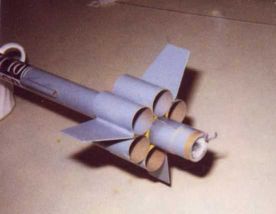
- Add the three TFNC G10 fins to alternate valleys of the tube fin array. Epoxy a straightened long Estes motor hook through the space between 2 tube fins, such that a retained motor will protrude about 3/8". Place the TFNC launch lug centered 3 1/4" above the tube fin can and precisely aligned with the space between the two tube fins opposite the motor hook placement (the 1/8" launch wire has to pass through here).
- Add recovery system to the lower section using your preferred attachment or the system and method that comes with the Vaughn TFNC. I prefer 6ft of parachute cord over the underpants elastic that comes in the kit and a 12in "lite" Top Flite chute.
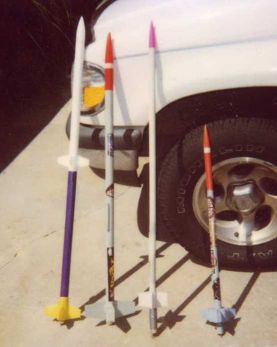
E-Qualizer is pictured with the other 3 rockets used in my NARTREK Gold project (pictured left to right are Quest-4-Estes, PipeCleaner, Mongoose, and E-Qualizer). The other three designs are all found in the EMRR website and you can read more about the NARTREK Gold project in the SPORT ROCKETRY May-June 2004 issue.
Finishing:
Finishing was with Testors flat battleship gray primer spray and red for the
payload section.
Flight:
E-Qualizer boosts straight and briskly on the E9-8 and D12-7, even with a
breeze. Altimeter reported 1240' on the E9 and 740' on the D12, which works out
to a rough drag coefficient (Cd) of 2.2 or so for the design, a bit high even
by tube fin standards. I was only able to get 2 measurements before a crash
ruined the altimeter. E9-6 and D12-5 are also possible motor choices but eject
a bit early. I nearly lost it on a single flight on an E30-7--super fast, out
of sight, and appeared to be climbing to at least the 1500' at 390 mph
predicted by simulation. I was afraid of a shred and too chicken to fly it with
my MicroAlt in the E30 flight).
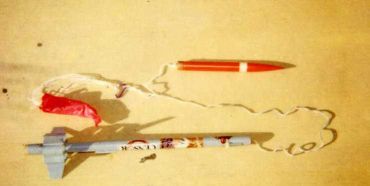 E-Qualizer
flies pleasantly on C11-5 motors as well, equivalent to the performance of an
Estes Big Daddy (350'). I have so far resisted the urge to fly E-Qualizer on an
F21-8 as simulations predict nearly 2000' at 400 mph. It would probably survive
structurally but a water landing would be a certainty at our island field here
in San Diego.
E-Qualizer
flies pleasantly on C11-5 motors as well, equivalent to the performance of an
Estes Big Daddy (350'). I have so far resisted the urge to fly E-Qualizer on an
F21-8 as simulations predict nearly 2000' at 400 mph. It would probably survive
structurally but a water landing would be a certainty at our island field here
in San Diego.
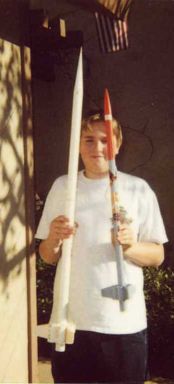 I have been
experimenting with an all-PVC, 29mm version of E-Qualizer to fly on G/H-power
as well. First test flight on an E30-7 (with adapter) was perfect, however, the
second flight CATO'd the E30 (front closure failure) and spectacularly torched
the PVC rocket body (PVC would make a good nitrous hybrid motor, maybe).
R&D continues.
I have been
experimenting with an all-PVC, 29mm version of E-Qualizer to fly on G/H-power
as well. First test flight on an E30-7 (with adapter) was perfect, however, the
second flight CATO'd the E30 (front closure failure) and spectacularly torched
the PVC rocket body (PVC would make a good nitrous hybrid motor, maybe).
R&D continues.
Summary:
PRO: A good fun fly rocket, and easy to build. Flies the E9-8 without nose
weight despite weighing only 88 grams. Very stable in wind.
CON: Vaughn kits no longer available, but could be scratch built from parts. A small rocket, thus can be easily lost if flown over 1000'. It is also unnecessarily draggy (way too much fin area) but I have since found better ways to achieve good performance combining light tube fin designs flying heavy motors.
 |
 |